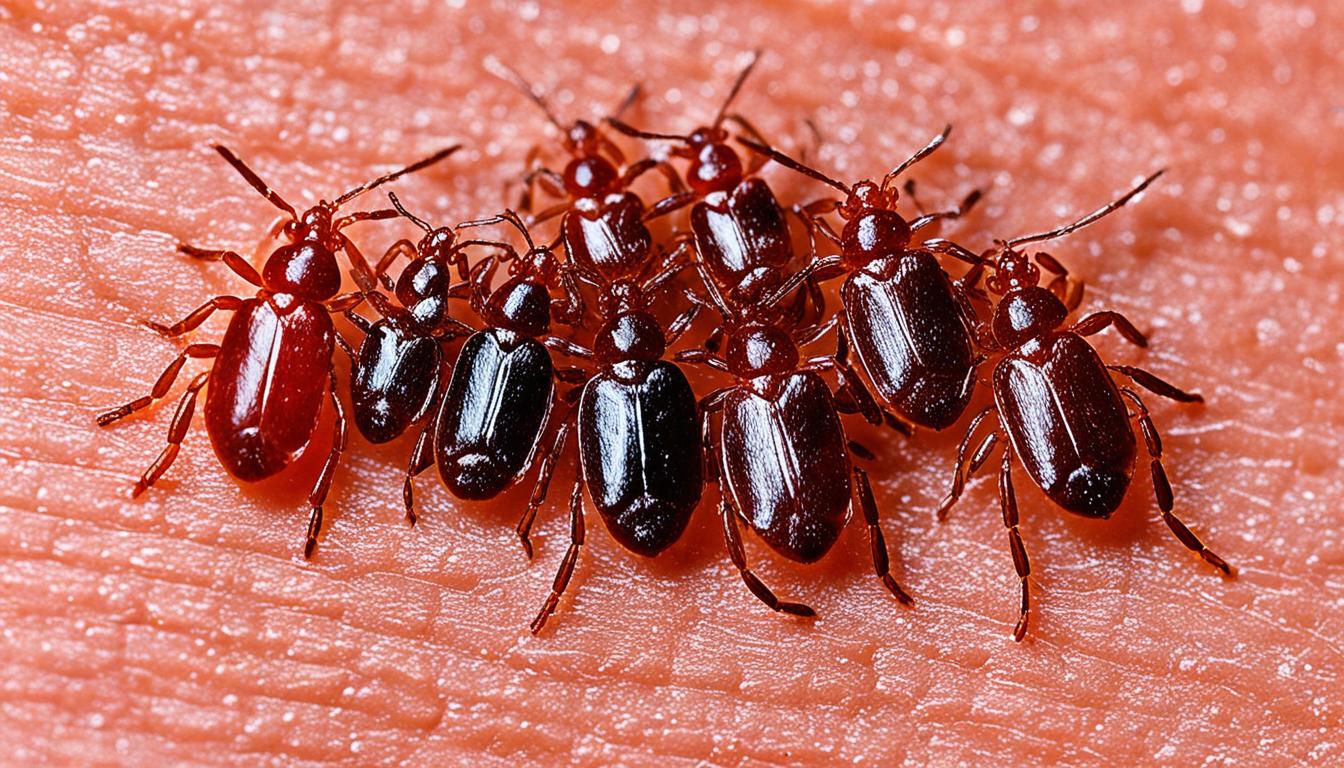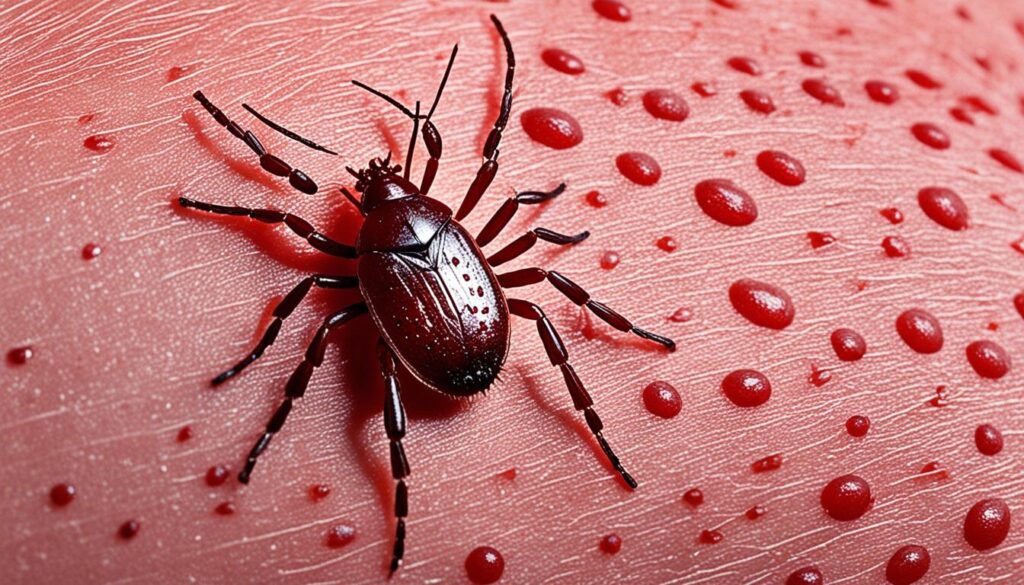Many of us know about adult ticks we find on our skin after being outside. But what about seed ticks? These tiny, young ticks are hard to see but can still cause trouble. So, what’s the deal with seed ticks?
Seed ticks are the young form of ticks, only about 0.5 to 1.5 millimeters in size. They are hard to spot but can itch a lot if they bite. It’s not confirmed if they spread diseases, but we should still be careful around them.
Ticks have four main stages in their life: egg, larva or seed tick, nymph, and adult. They need a new host, like a person or animal, for each stage. Seed ticks mostly come out in the summer, especially from July to September, and attack in groups.
Even though not all ticks make us sick, it’s smart to get rid of them fast. The CDC says to use fine-tipped tweezers to pull a tick straight out. Don’t cover the tick with nail polish. This can make things worse, as the tick might release more germs.
Key Takeaways:
- Seed ticks are ticks in the larval stage of their life cycle, ranging in size from 0.5 to 1.5 millimeters.
- They can attach themselves to humans and cause skin irritation, although their ability to transmit diseases is still uncertain.
- Ticks go through four life stages: egg, larva (seed ticks), nymph, and adult.
- Ticks require a new host for each stage of their life cycle, making tick removal crucial to reduce disease risk.
- To minimize the chances of encountering seed ticks, it’s important to take preventive measures such as removing leaf litter and wearing appropriate clothing.
Understanding Seed Ticks and their Life Cycle
A seed tick is a larval stage tick, meaning it’s in the second phase of life. It’s tiny, only about 0.5–1.5 millimeters long, and looks light in color. Unlike the eight-legged adults you might see, seed ticks have just six legs. They grow through four phases: egg, larva, nymph, and finally adult.
Seed ticks, in their larval stage, search for an animal or human to feed on. They find a host and attach themselves. Then, they stay there feeding for days before dropping off. Sometimes they attach again during their next phase as nymphs.
Remember not all ticks spread diseases, and not all who get bit show a rash. Out of the 900 tick species, only a few usually bite humans. In the U.S., the ticks you should be most careful of are the blacklegged tick, dog tick, and lone star tick.
Tick larvae are very active from July to September. Taking a shower soon after being outdoors can lower your risk of getting illnesses from ticks. Lyme disease, one of the more common illnesses, often starts with a rash that looks like a bull’s-eye. Other illnesses might cause different types of rashes, swollen lymph nodes, or ulcers at the bite site.
Symptoms and Risks Associated with Tick Bites
Tick bites bring various symptoms and risks of illnesses. Lyme disease is a common illness from ticks. In the early stages, about 70–80% of people will get a unique rash. This rash often looks like a bull’s-eye, with a red spot in the middle and a ring of red around it.
Other illnesses like STARI, tularemia, ehrlichiosis, and RMSF can cause different rashes. But not all tick bites cause rashes or spread diseases.
“About 70–80% of people who develop Lyme disease will develop a rash in the early stages, typically resembling a bull’s-eye.”
It’s crucial to watch for symptoms after a tick bite. If you notice any signs of an illness, like fever or fatigue, see a doctor right away. Diagnosing and treating tickborne diseases early can prevent complications.
Preventing tick bites is important. You can use tick repellents and wear protective clothing. Proper tick removal also lowers your risk of disease.
“Important preventive measures include treating clothes with permethrin to repel ticks, using insect repellents on the skin, and conducting thorough tick checks after outdoor activities.”
Not all tick bites are serious, but some can cause severe reactions. If you find a tick, remove it right away with tweezers. Then, clean the bite with antiseptic or soap and water.
Check for ticks all over your body and on pets after being outside. Use bug spray with DEET in tick areas. Wearing the right clothes helps too. Shower within two hours of coming inside to reduce your tick disease risk.
By being cautious and preparing, you can enjoy the outdoors safely.
Tick Prevention Strategies
To avoid tick bites, focus on keeping your surroundings tick-free. Since ticks are out most in warm weather, tackling the problem early is key. Here’s how you can block ticks effectively:
1. Remove Tick Habitats
Cut down on tick places by getting rid of leaf piles, tall grass, and thick bushes. Ticks love spots with lots of low, leafy growth. So, keep trees and bushes trimmed and the grass short. Paths made of mulch or crushed stone, and adding more sunlight, can also help.
2. Widen Trails
For paths through nature, making them broader reduces tick risk. Just clear plants from the sides and keep the trail well-marked and open.
3. Protect Yourself
When out in nature or gardening, wear clothes that cover your skin. Choose tops with long sleeves, pants, and shoes that cover your feet. By tucking your pants into your socks, you lower the chance of ticks getting on you. Light clothes also help you see ticks easily.
4. Use Tick Repellents
It’s smart to use tick repellents that you trust. Pick ones with over 20% DEET. Or consider items with permethrin for your clothes and gear. Permethrin keeps working even after a few washes and is great at keeping ticks off.
5. Perform Tick Checks
After being outside, check yourself, your family, and your pets for ticks. Look everywhere, especially in hidden spots like armpits and hair.
6. Shower Within Two Hours
Showering soon after you come home can remove ticks not yet attached.
These steps will go far in protecting you from ticks and the diseases they spread. If you need more tips, ask a health expert or visit the Centers for Disease Control and Prevention (CDC). They can offer advice on tick repellents and staying safe.
Tick Identification and Removal
Knowing how to identify and remove ticks is key to avoiding diseases they spread. Seed ticks are in the larval stage, with only six legs. They look like freckles or poppy seeds. Their bites can cause itching, redness, or swelling.
When you find a tick on your skin, take it off carefully and quickly. The CDC says to use fine-tipped tweezers. Here’s a quick guide:
- Grab the tick as near to your skin as you can.
- With even force, pull the tick out and make sure it’s whole.
- If parts of the tick stay in your skin, try to take them out too.
It’s very important not to try and suffocate the tick. Methods like covering it with nail polish or petroleum jelly don’t work well. Tweezers are best for safe removal.
Once the tick is out, clean your skin with antiseptic or soap to prevent infection. Look for any unusual signs or sickness near the bite area.
Remember, use tweezers to take out a tick straight. This way, you lessen the chance of leaving any parts behind.
Following the right steps for tick removal helps keep you and others safe from tick illnesses.
Seasonality and Habitat of Seed Ticks
Seed ticks, the youngest ticks, are most active in summer, especially in July, August, and September. They love places with lots of plants, like forests and gardens.
These tiny ticks can hide in leaf piles, on plants, and in dense bushes. You might not see them at first, but their bites can cause itching, swelling, and turn red.
When going outside or being in places where ticks are common, it’s important to be careful. Wear clothes that cover your arms and legs to prevent ticks from biting you.
It’s also a good idea to tuck your pants into your socks or boots for more protection. Ticks are easier to see on light-colored clothes, so you can remove them quickly.
Preventing Seed Tick Bites
To lower your chances of meeting seed ticks, it’s important to do a few things. Here are some key steps:
- Wear long pants, long-sleeved shirts, and closed-toe shoes
- Tuck pants into socks or boots
- Choose lighter-colored clothing
- Apply tick repellents with DEET or permethrin
- Check for ticks carefully after being outdoors
- Shower and wash your clothes in hot water to get rid of ticks you might have brought home
Following these tips will help you avoid seed ticks and the diseases they can carry while enjoying outdoor activities.
Tickborne Diseases and Symptoms
Tickborne diseases occur when ticks transfer germs to humans. These illnesses, like Lyme disease, can be serious. Other common ones are STARI, tularemia, ehrlichiosis, and RMSF.
Lyme disease is widespread in the US, affecting about 476,000 people yearly. It’s prevalent in the Northeast and Upper Midwest.
Only a few thousand people get Rocky Mountain spotted fever in a year. This disease shows up with fever, headache, and a special rash. Saint Louis encephalitis is even rarer, with 150 to 180 cases in ten years.
Babesiosis is spread by deer ticks. It affected under 1,800 people in 2013. Adults often show fever, tiredness, and anemia if they get this disease.
The symptoms of tickborne diseases vary. Lyme disease has a bull’s-eye rash. STARI, tularemia, ehrlichiosis, and RMSF show their own rashes. But not all cases have a rash, so symptoms can differ.
These illnesses can also cause fever, joint pain, and tiredness. If you notice these signs after a tick bite, see a doctor right away.
“Tickborne diseases are serious, and catching them early is important. If you feel sick after a tick bite, see a doctor for advice.”
Preventing these diseases means avoiding tick bites. Wear long clothes and use bug spray. Remove ticks fast and get checked by a doctor if you get sick.
Removing Seed Ticks and Preventing Tick Bites
Properly getting rid of seed ticks is key to stop diseases. Use tweezers to take off a seed tick from your skin. Grab the tick as close to your skin as you can, without twisting it. Slowly pull it out to make sure it all comes out and not just part of it.
After you get the tick off, clean the area well. Use soap with water or an antiseptic to clean it. This lessens any chance of getting sick and stops the area from getting more inflamed. Cleaning the area well is key to avoiding issues after removing the tick.
To avoid tick bites, you need to plan ahead. A tidy yard can discourage ticks. Cut the grass low, trim the bushes, and clear away leaves. This makes your home less inviting to ticks.
Wearing the right clothes can also help. Put on long clothes and closed shoes when you go to tick-heavy places. Stuffing your pants into your socks or boots can keep ticks away too.
Using tick repellent is another good way to protect yourself. Spraying on repellent with DEET or permethrin can keep ticks off. But, always use repellent the right way. If you’re unsure, ask a doctor or check the CDC’s advice.
After being outside, check your body for ticks thoroughly. Look in places people often miss, like your scalp or armpits. Finding ticks early and removing them fast lowers your risk of getting sick from them.
Professional Tick Control Services
Professional tick control services from Orkin Pro can be a big help. They create tick treatment plans just for you. Their team knows how to stop ticks from getting into your space.
Without help, tick numbers can grow fast. Some ticks that spread Lyme Disease can hatch thousands of eggs. Getting experts like Orkin Pro is important. They know their stuff and are trustworthy in tick control.
Orkin Pros carefully check your property for ticks. They figure out what kind they are and where they hide. They then use safe insecticides to treat those places. They also suggest changes to make your area less inviting to ticks.
Illnesses from tick bites can be really bad. This is why keeping ticks away is so important. As more ticks show up, taking care of your yard and getting professional help is key. Orkin Pro can help you manage ticks well, making your home or business safer.




